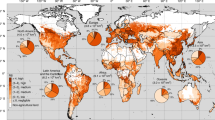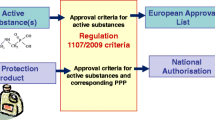Abstract
Pesticide users, natural resource managers, regulators, government agencies and many others are concerned about the off-site impact of pesticides on the environment. Systematic methods of the assessment of potential risk of pesticides to environmental components can serve as valuable tools in decision making and policy formulation. Simple risk indicators have been developed which cover a range of scenarios such as toxicity to organisms, health of farm workers, consumer health, and residues in harvested produce. The authors have developed a software package named Pesticide Impact Rating Index (PIRI) that outputs an improved pesticide risk indicator for water quality. PIRI is a standalone, user-friendly, platform-independent program. It can be used to (i) rank pesticides in terms of their relative pollution potential to groundwater or surface water, and (ii) to compare different land uses in a catchment or at a regional scale in terms of their relative impact on water quality. It is based on pesticides use; the pathway through which the pesticides are released to the water resources (drift, runoff, erosion, leaching) and the value of the water resources threatened. Each component is quantified using pesticide characteristics (including toxicity to organisms at different trophic levels, i.e. fish, daphnia, algae, etc.), environmental and site conditions (e.g. organic carbon content of soil, water input, slope of land, soil loss, recharge rate, depth of water table, etc.). This paper describes two case studies of the application of PIRI in Australia. The comparison of the risk assessment by PIRI on these revealed that PIRI correctly estimated the pollution potential of pesticides in greater than 80% of cases. A GIS version of PIRI is described in a companion paper in this volume.
Similar content being viewed by others
References
ANZECC: 1997, ‘Australian Water Quality Guidelines for Marine and Freshwaters. National Water Quality Management Strategy’, Canberra, Australia.
Balmer, M. E. and Frey, S.: 2001, ‘Swiss final report on the validation of OECD pesticides aquatic risk indicators’, http://www.oecd.org/dataoecd/15/21/2082191.pdf. Accessed 16 August 2004.
Brown, C. D., Hart, A., Lewis, K. A. and Dubus, I. G.: 2003, ‘Simulating the environmental fate of pesticides for a farm-level risk assessment system’, Agronomie 23, 67–74.
Cooper, B.: 1996, ‘Central & North West Regions Water Quality Program, 1995/96 report on pesticides monitoring’, TS 96.048, June 1996. Department of Land and Water Conservation, Parramatta. NSW.
Correll, R. L. and Dillon, P. J.: 1993, ‘Risk assessment as a framework for managing aquifers – A literature review’, AGSO Aust. J. Geol. Geophys. 14, 155–159.
EXTOXNET: 1998, ‘Extension Toxicology Network. A pesticide information project of Cooperative Extension offices of Cornell University, University of California, Michigan State University and Oregon State University.’ (http://ace.ace.orst.edu/info/extoxnet/).
Hornsby, A. G., Wauchope, R. D. and Herner, A. E.: 1996, Pesticide Properties in the Environment, Springer Verlag, New York. 227 pp.
Jury, W. A., Spencer, W. F. and Farmer, W. J.: 1983, ‘Behavior assessment model for trace organics in soil. I. Model description’, J. Environ. Qual. 12, 558–564.
Kennedy, I. R., Sanchez-Bayo, F., Kimber, S. W., Hugo, L. and Ahmad, N.: 2001, ‘Off-site movement of endosulfan from irrigated cotton in New South Wales’, J. Environ. Qual. 30, 683–696.
Knowles, T. A. and Singh, B.: 2003, ‘Carbon storage in cotton soils of northern New South Wales’, Aust. J. Soil Res. 41, 889–903.
Kookana, R. S. and Aylmore, L. A. G.: 1994, ‘Estimating the pollution potential of pesticides to groundwater’, Aust. J. Soil Res. 32, 1141–1155.
Kookana, R. S., Correll, R. and Miller, R.: 1998, ‘Assessing risk at catchment or regional level through a Pesticide Impact Ranking Index (PIRI)’, LWRRDC Occasional Paper No. 23/98, Canberra, Australia, 81–88.
Leonard, R. A.: 1990, ‘Movement of Pesticides into surface waters’, in H. H. Cheng (ed), Pesticides in the Soil Environment: Processes, Impacts and Modeling, Soil Science Society of America, Madison, Wisconsin, pp. 303–349.
Levitan, L.: 1997, ‘An overview of pesticide impact and risk assessment systems’, in OECD Workshop on Pesticide Risk Indicators, Copenhagen, 21–23 April.
Levitan, L., Merwin, I. and Kovach, J.: 1995, ‘Assessing the relative environmental impacts of agricultural pesticides: the quest for a holistic method’, Agri. Ecosyst. Environ. 55, 153–168.
Loague, K. and Corwin, D. L.: 1996, ‘Uncertainty in regional-scale assessments of non-point source pollutants’, in D. L. Corwin and K. Loague (eds), Applications of GIS to the Modeling of Non-Point Source Pollutants in the Vadose Zone, Soil Science Society of America, Riverside, CA, USA, 1–3 May 1995, pp. 131–152.
Lutz, W.: 1984, ‘Berechnung von Hochwasserabflüssen unter Anwendung von Gebietskenngrößen’, Mittlg. Inst. Hydrologie Wasserwirtschaft, Univ. Karlsruhe, Heft 24.
Maniak, U.: 1992, ‘Regionalisierung von Parametern für Hochwasserabflußganglinien’, in H. B. Kleeberg (ed), Regionalisierung der Hydrologie, DFG, Mittlg, Senatskomm. für Wasserforsch, 11, S, pp. 325–332.
Muschal, M.: 1997, ‘Central and North West Regions Water Quality Program, 1996/97 report on pesticide monitoring’, Report Ecosystem Management CNR97.063, October 1997, New South Wales Department of Land and Water Conservation, Parramatta, NSW, Australia, ISSN 1327–1032.
OECD: 1998, ‘Pesticide Aquatic Risk Indicators Project: Annex 2: Report of Phase 1 of the. OECD Secretariat, France’, http://www.oecd.org/dataoecd/31/36/2078678.pdf. Last accessed 7 October 2003.
Pollock, D., Kookana, R. and Correll, R.: 2004, ‘Integration of the Pesticide Impact Rating Index with a Geographic Information System for the assessment of pesticide impact on water quality’, J. Water, Air Soil Pollut. (this volume).
Rao, P. S. C., Hornsby, A. G. and Jessup, R. E.: 1985, ‘Indices for ranking the potential for pesticide contamination of groundwater’, Proceedings Soil and Crop Science Society of Florida 44, 1–8.
Raupach, M. R., Briggs, P. R., Ahmad, N. and Edge, V. E.: 2001, ‘Endosulfan transport: II Modeling airborne dispersal and deposition by spray and vapor’, J. Environ. Qual. 30, 729–740.
Reus, J., Leendertse, P., Bockstaller, C., Fomsgaard, I., Gutsche, V., Lewis, K., Nilsson, C., Pussemier, L., Trevisan, M., van der Werf, H., Alfarroba, F., Blümel, S., Isart J., McGrath, D. and Sepälä, T.: 2002, ‘Comparison and evaluation of eight pesticide environmental risk indicators developed in Europe and recommendations for future use’, Agri. Ecosyst. Environ. 90, 177–187.
Sanchez-Bayo, F., Baskaran, S. and Kennedy, I. R.: 2002, ‘Ecological relative risk (EcoRR): Another approach for risk assessment of pesticides in agriculture’, Agri. Ecosyst. Environ. 91, 37–57.
Shaw, A. J. and Watson, C. R.: 2001, ‘Cotton Pesticide Management Guide 2001/2002’, NSW Agriculture, Orange, NSW, Australia, ISSN 1442–8792.
USEPA: 2000, ‘Drinking water standards and health advisories’, Office of Water, U.S. Environmental Protection Agency, Washington, DC EPA 822-B-00-001, Summer 2000.
van der Werf, H. M. G.: 1996, ‘Assessing the impact of pesticides on the environment’, Agri., Ecosyst. Environ. 60, 81–96.
Verro R., Calliera, M., Maffioli, G., Auteri D., Sala, S., Finizio, A. and Vighi, M.: 2002, ‘GIS-based system for surface water risk assessment of agricultural chemicals. 1. Methodological approach’, Environ. Sci. Technol. 36, 1532–1538.
Wauchope, R. D., Yeh, S., Linders, J. B. H. J., Kloskowski, R., Tanaka, K., Rubin, B., Katayama, A., Kordel, W., Gerstl, Z., Lane, M. and Unsworth, J. B.: 2002, ‘Pesticide sorption parameters: theory, measurement, uses, limitations and reliability’, Pest Manag. Sci. 58, 419–445.
Wilson, J. P., Inskeep, W. P., Rubright, P. R., Cooksey, D., Jacobsen, J. S. and Snyder, R. D.: 1993, ‘Coupling geographical information system and models for weed control and groundwater protection’, Weed Technol. 7, 255–264.
Author information
Authors and Affiliations
Corresponding author
Additional information
An erratum to this article is available at http://dx.doi.org/10.1007/s11267-005-4108-3.
Rights and permissions
About this article
Cite this article
Kookana, R.S., Correll, R.L. & Miller, R.B. Pesticide Impact Rating Index – A Pesticide Risk Indicator for Water Quality. Water Air Soil Pollut: Focus 5, 45–65 (2005). https://doi.org/10.1007/s11267-005-7397-7
Issue Date:
DOI: https://doi.org/10.1007/s11267-005-7397-7




